- Publisher's Note
- Editorial
- Looking from the Other Side
- Women in Rabindranath Tagore's Paintings
- Ramkinkar Baij's Santhal Family
- The Birth of Freedom in Moments of Confinement
- Jamini Roy's Art in Retrospect
- The Great Journey of Shapes: Collages of Nandalal Bose
- Haripura Posters by Nandalal Bose: The Context and the Content
- The Post-1960s Scenario in the Art of Bengal
- Art Practice in and Around Kolkata
- Social Concern and Protest
- The Dangers of Deifications
- Gobardhan Ash: The Committed Artist of 1940-s
- Gopal Ghose
- Painting of Dharmanarayan Dasgupta: Social Critique through Fantasy and Satire
- Asit Mondal: Eloquence of Lines
- The Experiential and Aesthetic Works of Samindranath Majumdar
- Luke Jerram: Investigating the Acoustics of Architecture
- Miho Museum: A Structure Embedded in the Landscape
- Antique Victorian Silver
- Up to 78 Million American Dollars1 !
- Random Strokes
- Are We Looking At the Rise of Bengal
- Art Basel and the Questions it Threw Up
- What Happened and What's Forthcoming
- Art Events Kolkata, May – June 2012
- Mumbai Art Sighting
- Delhi Dias
- Art Bengaluru
- Preview June, 2012 – July, 2012
- In the News, June 2012
ART news & views
The Post-1960s Scenario in the Art of Bengal
Issue No: 30 Month: 7 Year: 2012
by Dr. Nandini Ghosh
Post-1960s modernist art practices in Bengal began to be increasingly marked by subjective concerns. Such subjectivity worked itself through political consciousness, engagement with social issues, as well as a concern for defining identity especially within a regional aspiration however subliminal all of these might appear to be, when anticipated in terms of the immediately evident at the visibly formal level in an art object.
The post 1960s generation had spent its childhood, adolescence and subsequent maturity at a time when Bengal as a region was passing through one of the darkest phase in its post-independence history. This refers to the socio-economic dislocation caused by several factors and their after-effects the famine, post-war presence of the allied forces in the city of Kolkata, communal riots in Bengal and in the neighbouring East Pakistan subsequently leading to a large diaspora of the Hindu community shifting over into West Bengal, and so on. These were followed by political disturbances spurned by severe mis-governance during the decades of the 1950s and the 1960s, resulting in violent protests against economic disparity, joblessness, shortage of food and fuel etc. As a consequence of all of these, Bengal saw a massive peoples' movement for food, public upsurge against hike of transport (tram) fares, labour movements in major industrial sectors, and protest-movements for acquiring democratic rights, which served to provide a considerable jolt to the socio-cultural status quo in the region.
The decade of the 1950s was also witness to protest movements within the academic milieu, most importantly from amongst students. It was this decade when student bodies and unions began to assume a strong voice in academic institutions with significant extended contribution and active participation to mainstream politics. This was a significant development, for it was in these sensitive and socially conscious young idealistic revolutionaries wherein lay the future succession of the forthcoming decades from politics to culture, from development to economy and from governance to humanity. All these developments in the decade of the fifties would hold an immensely significant implication for the decades of the seventies and later as a foundational backdrop for forthcoming developments.
The end of the 1960s and the early 1970s was a moment of political transition. The Naxalite movement and its associated violence, the economic situation and the pressure generated thereby, as well as the imposition of the Emergency with its characteristics of censorship of public voices and the media (newspapers, magazines etc) once again generated the ground for protest-movements.
Coupled with the contemporary socio-political disturbances, and a gradual fading through temporal distance from the pre-colonial and colonial memories, was an intense feeling of loss and rootlessness within individuals who had immigrated to this side of the border in Bengal from East Pakistan; their uprooted status created an atmosphere of aimlessness on the one hand, and a desperation on the other, to ensure a mere minimum of subsistence. The sum-total of this socio-cultural situation may well be presumed to have structured the response patterns in the responsive artists.
The gloom that characterized the situation continued into and through the 1970s, and reached a peak with the imposition of political Emergency in mid 1970s; even more severely, individuality and voices of freedom found themselves threatened and at stake. The visual artist, as part of the same ambience, was obviously extremely unhappy with the turn of events, but saw no immediate way out of the ensuing turmoil and violence. Amidst such a bleak circumstance the visual artist's search for a new language of protest found expression through the modes of formal distortion, satire and pun, in a way that the art of the post-60s was characterized by changes that focused more on the regional identity.
Distinct from their immediate predecessors, the early modernists of the nineteen forties and fifties, whose visual practice concentrated on the formal aspects of art, based on the pictorial styles and languages imbibed from developments in the Western modern (consider the instance of the Calcutta Group referring to Impressionism, Cubism, Surrealism etc, both in their proclamation as well as practice), artists of the nineteen-sixties through seventies embarked on a different trajectory.
Among the young artists of the post-60s to be reckoned with, a significant segment were art school graduates, mostly in their twenties. While these rising aspirants shared a strong disapproval of the existing state of visual arts, they were neither entirely clear nor immediately certain about a valid alternative in visual expression to be able to formulate a mature linguistic structure. Much like the nineteen-forties, this was once again a moment in transition, seeking a contextually relevant mode of expression that would be a valid voice to the then-current status of the modern.
To envisage the 60s and the post-60s in terms of broad categories and tendencies in visual arts, one could possibly begin with artists who continued into the decades from an earlier era, carrying along with them the directions that they had been exploring since then. Amongst such artists one could probably draw upon the instance of Somnath Hore (and to an extent his senior contemporary Chittaprosad, though the latter was mostly stationed in Mumbai), and mark this trajectory as that of a politically conscious genre triggered off through the artists' ideological consonance with a Marxist ideology, however personally interpreted. On the other hand, one could claim a simultaneous though distinct trajectory of formalist modernism in the individual efforts of another section of artists. A third trajectory could be classified as a continued transmutation of the “Bengal school” idiom, sometimes in consonance with its philosophy and world-view and at other moments merely as a formal mannerism.
Both the formal modernists as well as those continuing along the parameters of the Bengal school provided possibilities of a continued line of heritage, if to be followed. But more importantly, a significant point of departure within an otherwise shared continuity of concerns would be evidenced in the instance of Ramkinkar Baij in Santiniketan, who most profoundly proposed a “contextual modern” that in varied ways brought together tradition and modernity at a crucial juncture.
The post-60s generation was certainly informed about their predecessors, characterized by an awareness of international politics and a modernist commitment to express the contemporary human situation. Visual art shared a close proximity with Bengali literature especially poetry and theatre. However, despite the fact that the young generation tended to idolize/idealize the past, they also felt the urge to outgrow established trends. The new generation art of the mid-1960s and the 1970s differed from that of their seniors; instead of a stress on equating with the formal aspects of the Western modern, the focus was now concentrated on subjectivity and the immediate social ambience sometimes even a marked discomfort regarding the adoption of elements from western tradition.
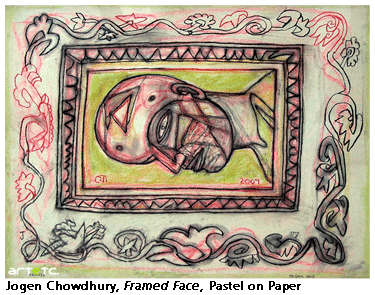 Jogen Chowdhury's images emerged out of his memories of the land he left behind. Forced by socio-political circumstance to emigrate to India, nostalgia in the symbolic form of dream and fantasy cloaked his pictorial statements. In the mid-60s he made a concerted attempt to break out of the academism of his art school training, through the usual devices of distortion, an eerie form and the harshness of a critical line. In the following decade of the 70s, the grim fantasies reached a formal clarity, but the darkness of content persisted. Through this decade, his thematic concern became tinged with the desperation that typifies common man's attempt to survive in difficult times. But this commitment to social reality did not manifest in a directly descriptive mode either he transmuted the theme into symbolic imagery, or else the portrayed characters emerged as types rather than specific individuals. Such an allegorical and satiric mode invariably involves a reinterpretation and contextual re-reading of traditional mythic material. His series of “Ganesha”-s are a case in point.
Jogen Chowdhury's images emerged out of his memories of the land he left behind. Forced by socio-political circumstance to emigrate to India, nostalgia in the symbolic form of dream and fantasy cloaked his pictorial statements. In the mid-60s he made a concerted attempt to break out of the academism of his art school training, through the usual devices of distortion, an eerie form and the harshness of a critical line. In the following decade of the 70s, the grim fantasies reached a formal clarity, but the darkness of content persisted. Through this decade, his thematic concern became tinged with the desperation that typifies common man's attempt to survive in difficult times. But this commitment to social reality did not manifest in a directly descriptive mode either he transmuted the theme into symbolic imagery, or else the portrayed characters emerged as types rather than specific individuals. Such an allegorical and satiric mode invariably involves a reinterpretation and contextual re-reading of traditional mythic material. His series of “Ganesha”-s are a case in point.
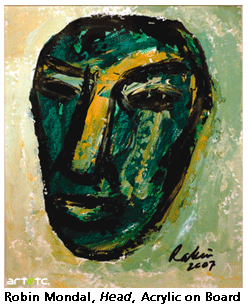 On the other hand, Rabin Mondal's clustered groups placed in claustrophobic compressed spaces form an enactment of social symbolism it is possible to read through them the experience of teeming multitude of refugees in Kolkata, and the psychological disquiet of urban space dislocated by a disruptive social fabric. While the restless application of impasto pigment draws analogy to the condition of suffering, the iconic presence of the human forms subtly recalls the persisting pride in lineage that one desperately hangs on to despite an utterly debased present.
On the other hand, Rabin Mondal's clustered groups placed in claustrophobic compressed spaces form an enactment of social symbolism it is possible to read through them the experience of teeming multitude of refugees in Kolkata, and the psychological disquiet of urban space dislocated by a disruptive social fabric. While the restless application of impasto pigment draws analogy to the condition of suffering, the iconic presence of the human forms subtly recalls the persisting pride in lineage that one desperately hangs on to despite an utterly debased present.
By contrast, the watercolours by Shyamal Dutta Roy would be typical examples of romantic symbolism from the decade of the seventies. The iconic recurrence of the ruined and the spent became an index to the economic helplessness of a social class, and the pleasant landscape of the 1950s-60s seems permanently lost. On the other hand, Ganesh Pyne's world of private fantasies is a distinctly different strategy, where mysterious shadows balanced by ethereal light re-invoked a lingering lyricism identified with the Bengal school in an distinctly different context. His credit lies essentially in the successful harnessing of the lyrical language into images of silent expressionistic vigour, through the strange and even the morbid (a constant reference to death, for instance, in the skeletal forms), such that these eventually reached a point far from the mythical fantasies of the Bengal school tradition. Surreal fantasy also characterized Dharmanarayan Dasgupta's tempera paintings, but in their image potential they remained distinct from the world of Ganesh Pyne. At a primary formal level, the common territory between the two could be located in a coincidental mystery of the dark void, but in contradistinction to Pyne's mode of expression, Dasgupta combines more readily the essence of indigenous miniature painting traditions of the past with a thematic-conceptual concern for the then-present times, such that the resulting lyricism has an exceedingly contemporary look.
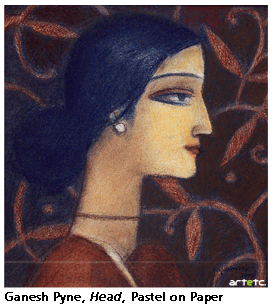

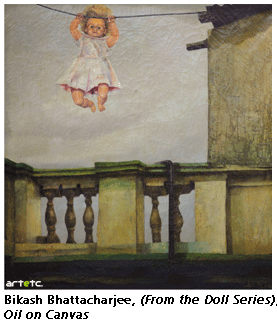 It was in the decade of the seventies that Bikash Bhattacharya's Doll series emerged as a gesture of shattering the silence forced upon a community, defying political threat through sharp yet subtle pictorial statements. The duality of real-surreal in these images arose out of the self-conscious engagement with an illusory naturalistic pictorial language which was then transported beyond the obvious and the immediate through eerie and uncanny disjunctions, amplified moreover by the absent presence of the human element. Conventionally the series has been viewed in the context of the Naxalite experience, and the symbolic implication of the content manifests as much in the uncanny loneliness of the vacant city as in the primary object of meditation, the dolls, painted against it.
It was in the decade of the seventies that Bikash Bhattacharya's Doll series emerged as a gesture of shattering the silence forced upon a community, defying political threat through sharp yet subtle pictorial statements. The duality of real-surreal in these images arose out of the self-conscious engagement with an illusory naturalistic pictorial language which was then transported beyond the obvious and the immediate through eerie and uncanny disjunctions, amplified moreover by the absent presence of the human element. Conventionally the series has been viewed in the context of the Naxalite experience, and the symbolic implication of the content manifests as much in the uncanny loneliness of the vacant city as in the primary object of meditation, the dolls, painted against it.
The response to the social violence of the period resulted in fragmented forms in the paintings by Prokash Karmakar. Convulsive, raging animal forms most often, horses lashed out across the pictorial space. However, these were not singular wholes, but rather aggregates of numerous splintered silhouettes that seem to came together only to disperse back into blasted fragments again. As the unbridled energy on a rampage fragmented itself, there was no optimistic promise of a better day to come. The conventional resolution of good-wins-evil was absent here; rather, it stood out as a document of the troubled times in the garb of secular mythologies.
Where and how could one position the post-1070s in relation to the characteristics of the post-60s? Would it be proper to view the subsequent decades as a total rupture with the past and a stepping-in towards an entirely different generational distance, or could we map continued concerns and negotiations that evidence transitions, however disjunct and abrupt or smooth and gradual?
While in certain instances the post-70s scenario might appear to be a diluted continuation of the previous era, with a merry crop of landscapes, playful myth-making and storytelling, and the rapid adaptation of elements of folk forms, in an overall sense the earlier gloom which manifested through dark colour-tones and intense textural applications began to give way to illuminated pastel shades, and an associated 'lightness' of expression. Concurrently, the seriousness of engagement from the previous decades extended in artists like Bikash Bhattacharya, who continued to remain active in the post-70s decade, as well as in younger artists like Shuvaprasanna and Samir Aich who too evolved into individual and personal directions.
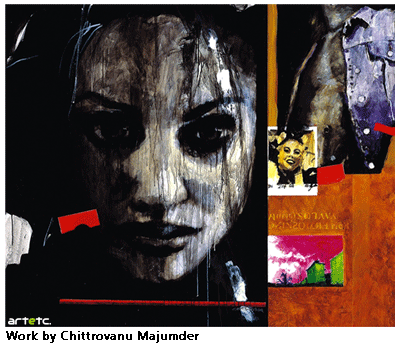
The post-70s era saw the Left front regime of a decade in existence, more stabilized and in assured control. Simultaneous to this was a gradual shift in economy; the post-70s saw the rise of private art galleries, an index to the developing impact of an art-market in the making. This transition forms the backdrop for new trends and in artists like Jayashree Chakraborty and Chittravanu Majumdar welcomed new trends in medium and format as well as subjectivity. This was the moment of advent of new media/new expression in the region the inception of which, however, needs to be traced in artists of a relatively senior generation, like Parthapratim Deb, who had begun working in these decades though he achieved a due recognition in more recent times. Even painters like Badhan Das, who continued along the high-modernist principles of abstraction, turned to mixed media as a liberating gesture.

But a more radical mode of departure would be the introduction of installations, site specific or otherwise, in which the exploration of new media crossed boundaries of the conventional, dissolving the traditional distinction between varied forms of cultural expression. From Jayashree Chakraborty and Chittravanu Majumdar to Manjari Chakraborty, Chhatrapati Dutta, Paula Sengupta and the much younger Sraboni Roy, the conventional distinction between the painted and the constructed space was increasingly blurred. On the other hand, painters like Prasanta Sahu and Amritah Sen as well as sculptors like Pankaj Panwar and Debanjan Roy redefined the limits of the traditional formats without necessarily venturing into multi-media explorations.
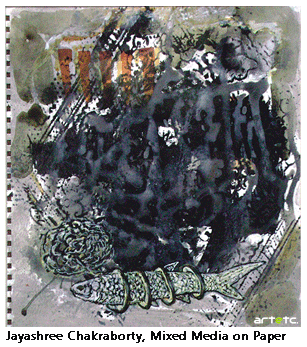
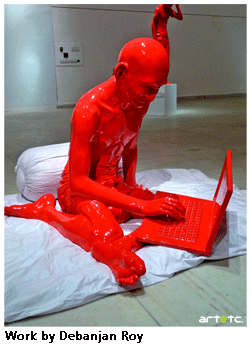
Curiously enough, what was once upon a time an aspiration for the 'international' now transformed into a conviction in the 'global', but the 'post-modern' simultaneously recalled the category of the 'regional' and the 'local' so that it is the complex dynamics of all of these, and the varied negotiation and resolution of the same that characterizes contemporary visual practice.